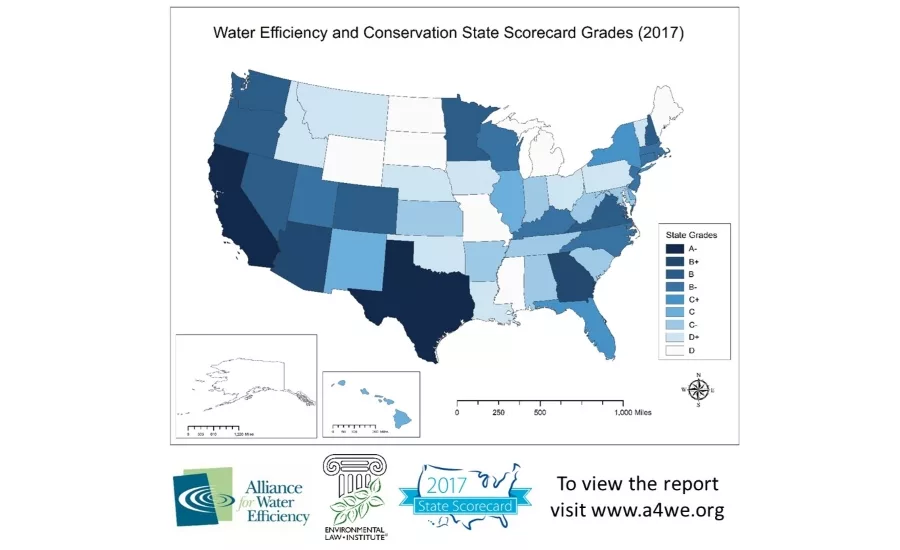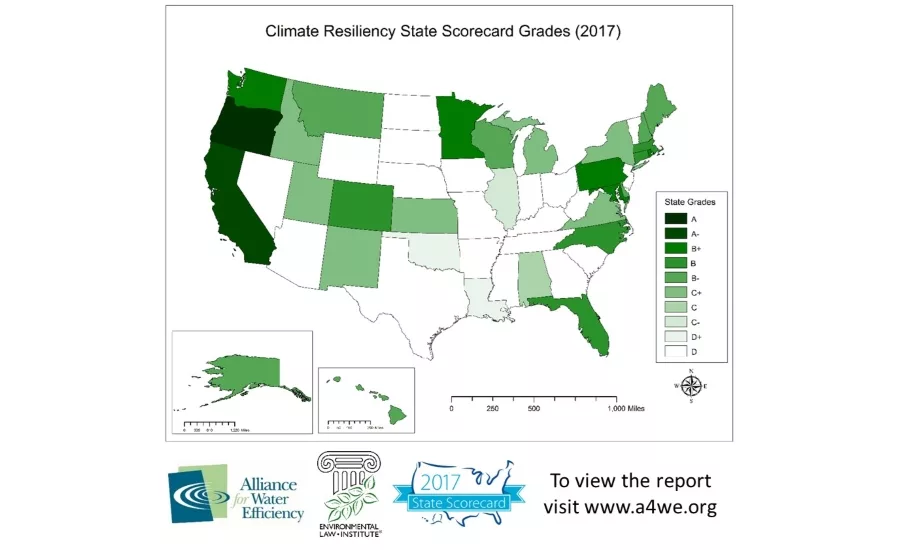Scorecard: States earn a C in water efficiency, conservation
Alliance for Water Efficiency, Environmental Law Institute release 2017 Water Efficiency and Conservation State Scorecard


According to a report released today by the Alliance for Water Efficiency (AWE) and the Environmental Law Institute (ELI), most states have a long way to go to shore up their legal frameworks and improve requirements that contribute to water conservation and efficiency, and long-term resiliency. In the 2017 Water Efficiency and Conservation State Scorecard update, each state received two separate grades: one for efficiency and conservation and one for climate resiliency planning. As the number of droughts and water shortages continues to increase nationally, the existence of state-level laws that advance water efficiency and conservation is becoming more critical. The national average for water efficiency and conservation is a “C,” despite progress made by more than half of states since the 2012 State Scorecard.
The 2017 State Scorecard update identified some key trends and notable states:
- California and Texas both received an “A-,” the highest grades in the country; California and Texas were also the leading states in 2012.
- Colorado and Illinois have legislatively linked water efficiency requirements for toilets, urinals, showerheads, and other fixtures to the WaterSense standard.
- Georgia and New York have supplemented their respective state plumbing/building codes with water efficiency requirements for various fixtures that are more stringent than the national standards.
- Overall, more than half of all states saw their grades improve. Only six states had declines in scores.
“The progress made by many states in the past five years is encouraging, but all states have more to do to meet the significant water supply challenges ahead. Leaders such as California and Texas provide a path for others to follow,” said Mary Ann Dickinson, President and CEO of the Alliance for Water Efficiency. “States can achieve quick wins by investing in lower-cost initiatives that provide immediate water savings and build resiliency, such as stronger standards for fixtures and drought planning at the state and local levels.”
Seven states discontinued or decreased designated funding for urban conservation programs. About this issue, Dickinson added, “We hope that declining funding for efficiency is not a continuing trend. Water efficiency investments are sound economic strategiesand should remain an important piece of every state’s water funding portfolio.”
The climate resiliency portion revealed that many states are unprepared for potential climate change impacts on water supplies, even those that may be leading in water efficiency and conservation policy. Like the water conservation and efficiency scores, the climate resiliency scores ranged significantly, with the national average being a “C.”
- Oregon paved the way scoring the only “A,” while California scored the only “A-.”
- Texas, Arizona, and Georgia, which were in the top five for conservation and efficiency, all received D’s for their climate resiliency planning.
- Twenty-three states had no plans of any kind regarding resiliency and climate adaptation. Of those states that do have plans, California, Idaho, Maryland, Minnesota, Oregon, and Pennsylvania were the only six to require plan updates every five years or fewer. Meanwhile, only five states have any kind of benchmarking in place: California, Oklahoma, Oregon, Hawaii, and Washington.
Data for both the conservation and climate resiliency preparedness portions indicate that geography is not necessarily an indicator of a state’s approach to addressing the issues covered by the report.
Adam Schempp, a Senior Attorney at the Environmental law Institute, said, “More than half the states improved their water conservation and efficiency scores, demonstrating how widespread developments in those laws have been. The leaders in this area continue to move the needle, and some states from whom little was previously seen are taking promising steps. The addition of a resiliency planning score provides another perspective on preparation, and the two grades were surprisingly dissimilar for many states.”
“We undertook this work to provide a resource for planners, policy makers, and water professionals who want to improve their state’s approach to managing fresh water resources," Alliance for Water Efficiency President and CEO Mary Ann Dickinson said. "We hope that states will use this information and be motivated to improve their commitment to water supply management and resiliency planning.”
For nearly a decade, AWE has been working to identify and raise awareness about state-level laws that encourage water conservation and efficiency. In 2012, AWE and ELI released the first Water Efficiency and Conservation State Scorecard: An assessment of laws and policies. Five years later, AWE and ELI have released an update based on an expanded survey and a new climate resiliency component.
The report and accompanying materials are available here.
AWE and ELI are grateful to the Turner Foundation, which partially funded this important research.
Looking for a reprint of this article?
From high-res PDFs to custom plaques, order your copy today!







